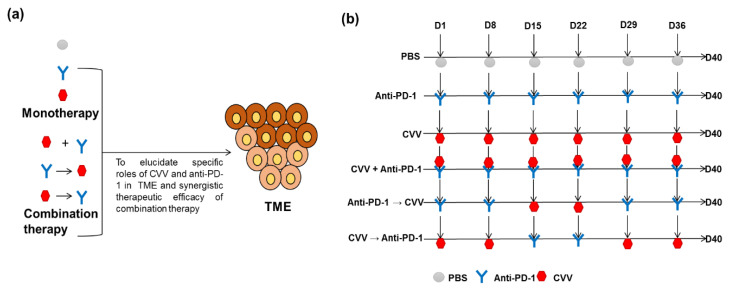Figure 2.
Monotherapy and combination therapy of CVV and anti–programmed cell death protein-1 (anti-PD-1). (a) Combination therapy strategies. To reveal the specific effects of CVV and anti-PD-1 in the therapeutic efficacy of combination therapy, mice were divided into three groups: CVV+anti-PD-1, anti-PD-1→CVV, and CVV→anti-PD-1. (b) Weekly combination therapy schedule. Subcutaneous CT26 tumors were induced in six-week-old male Balb/c mice using 5 × 106 CT26 cells/100 µL of 1X phosphate-buffered saline (PBS). After the tumor volume reached 100 mm3, mice were separated into different groups for treatment (n = 8–10 in each group). The control group received 100 µL of 1X PBS up to six weeks (D1, D8, D15, D22, D29, D36, and D40). The anti-PD-1 group received 250 µg of RMP1-14 intraperitoneally up to six weeks. The CVV group received 1 × 107pfu of CVV intratumorally up to six weeks. The CVV+anti-PD-1 group received both RMP1-14 and CVV on the same days up to six weeks. The anti-PD-1→CVV group received RMP1-14 consecutively for the first two weeks (D1 and D8), followed by CVV for the next two weeks (D15 and D22) and RMP1-14 injection was repeated for the last two weeks (D36 and 40). The CVV→anti-PD-1 group received CVV consecutively for the first two weeks (D1 and D8), followed by RMP1-14 for the next two weeks (D15 and D22), and CVV injection was repeated for the last two weeks (D36 and 40). The dosage and route of administration were the same as in the monotherapy groups. Two independent experiments were carried out as per the above schedule.

